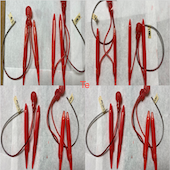Back
Poster, Podium & Video Sessions
Podium
PD52: Sexual Function/Dysfunction: Surgical Therapy II
PD52-09: Low Concentration Chlorhexidine Gluconate (CHG) in Sterile Water Solution Adherence Dip Time, Effect on the Hydrophilic Inflatable Penile Prosthesis (hIPP) Coating, and Patient Tolerance.
Monday, May 16, 2022
8:20 AM – 8:30 AM
Location: Room 252
Ryan Griggs*, Bossier City, LA, Edward Karpman, Mountainview, CA, Wei Zhang, Eden Prairie, MN, Gerard Henry, Bossier City, LA
- RG
Ryan P. Griggs, DO
Fellow
Podium Presenter(s)
Introduction: Inflatable penile prosthetic infections can lead to both devastating medical and economic consequences. One key advance in infection prevention, was the development of the hIPP as it can absorb any antimicrobial solution. Literature reports a myriad of solutions, though the ideal combination and dipping time duration have yet to be described. CHG is an extremely broad-spectrum antimicrobial that has been used for preoperative skin preparation for years. The Irrimax corporation has developed a low concentration CHG solution; it is the first FDA cleared intra-corporal antimicrobial wound lavage in humans. Per company statements, it innately covers >99% of bacteria, viruses, and fungi that were tested. When considering a novel dipping solution, we must weigh its efficacy and possible caustic properties on the device itself and on human tissue. Our experiment is three-fold. One, to determine the solution's affects on the hIPP. Secondarily, we sought to evaluate adherence with increased dip time of 1, 15, 30, and 60 minutes. Lastly, we explored patient tolerance.
Methods: Pre-connected hIPP components were tested. They were soaked in the CHG solution or normal saline for 1, 15, 30 and 60 minutes. Subsequently, all parts were dried in a 35°C oven for 15 minutes. The Congo Red Dye Test was performed following a Coloplast validated test method, which ensures product reliability (figure 1). We retrospectively reviewed our single surgeon database and 88 patients over the past 2 years had a hIPP and CHG lavage; identified charts were evaluated for allergic reactions.
Results: All components of the pre-connected hIPPs were tested. Despite increasing intervals, all achieved satisfactory coating. There were no noticeable differences in caustic affects. After chart review, there were no allergies or skin reactions to the solution suggesting that it is well tolerated.
Conclusions: The low concentration CHG solution does not affect the hIPP's coating when compared to saline. Additionally, there was no difference observed in adherence with increased dip time. Lastly, the solution is seems to be well tolerated. Biocompatibility and long-term device performance still need to be verified.
Source of Funding: Coloplast

Methods: Pre-connected hIPP components were tested. They were soaked in the CHG solution or normal saline for 1, 15, 30 and 60 minutes. Subsequently, all parts were dried in a 35°C oven for 15 minutes. The Congo Red Dye Test was performed following a Coloplast validated test method, which ensures product reliability (figure 1). We retrospectively reviewed our single surgeon database and 88 patients over the past 2 years had a hIPP and CHG lavage; identified charts were evaluated for allergic reactions.
Results: All components of the pre-connected hIPPs were tested. Despite increasing intervals, all achieved satisfactory coating. There were no noticeable differences in caustic affects. After chart review, there were no allergies or skin reactions to the solution suggesting that it is well tolerated.
Conclusions: The low concentration CHG solution does not affect the hIPP's coating when compared to saline. Additionally, there was no difference observed in adherence with increased dip time. Lastly, the solution is seems to be well tolerated. Biocompatibility and long-term device performance still need to be verified.
Source of Funding: Coloplast


.jpg)
.jpg)